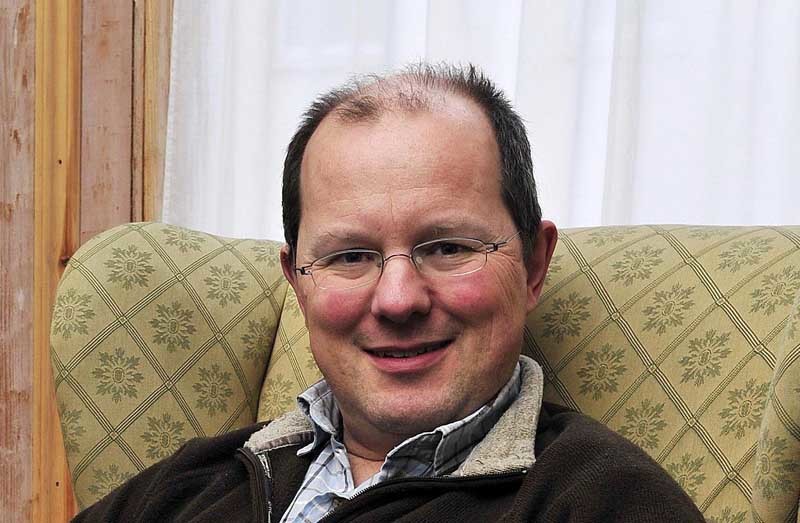We’ve all heard it. The global temperature over the last few decades is accelerating, running away, threatening the planet. Except it’s not at least according to Milnathort author and blogger Andrew Montford. Bruce Robbins finds out more.
Andrew Montford isn’t alone in reaching his conclusion that the science behind climate change has been corrupted to suit political and environmental agendas. But the thousands of scientists who agree with him, shattering the so-called “consensus” that global warming is man-made, struggle to have their voices heard over the latest doom-laden predictions emanating from the United Nation’s Intergovernmental Panel on Climate Change (IPCC) and the shrill demands from green activists and politicians that we have to slash CO2 emissions to save polar bears.
Andrew’s book, The Hockey Stick Illusion, charts in great detail the efforts of a sceptical mining industry consultant and statistician, Steve McIntyre, to take apart a graph that became know as the Hockey Stick. The iconic Hockey Stick, put together by US climate scientist Michael Mann, is important to proponents of anthropogenic (man-made) global warming (AGW) because it became the cheerleader for the IPCC’s influential Third Assessment Report on climate change the tool used to sell the Kyoto Protocol to the public.
Andrew, who moved to Scotland from his native Surrey 25 years ago to gain a chemistry degree at St Andrews University, has watched the global warming story unfold over recent years and grown increasingly slack-jawed by it all. With a background in accountancy and a business knocking scientific papers and books into shape for publishers, he wasn’t fazed by McIntyre’s statistics-based analysis or the dense scientific text of which climate change papers are composed. It’s a triumph that Andrew has managed to break the episode down and re-assemble it in a way that has transformed the Hockey Stick saga into a compulsive detective story.
McIntyre’s forensic dissolution of the Hockey Stick achieved what the IPCC’s much-vaunted “peer review process” failed to deliver independent scrutiny of the issue. His work resulted in the Hockey Stick being discredited as an accurate temperature record. There were subsequent attempts through new scientific papers by AGW scientists to bolster the Hockey Stick but these, too, were found wanting when McIntyre set to work.Blog trafficIt was the Canadian’s indefatigable efforts that got Andrew interested in global warming and led to him starting his own Bishop Hill blog to put the climate change sceptic’s point of view. After the publication of a paper charting the hockey stick story up to that point, the number of readers of his blog increased practically overnight from 300 to 30,000 per day.
He told The Courier, “My interest in the subject was piqued when I came across McIntyre’s Climate Audit website and I liked the idea of looking into what he was doing. When readership of my blog shot up to 30,000 hits I realised that my next paper wasn’t going to be a paper but a book. I hope the book will persuade people that there’s a problem with the science. In an ideal world, it would change the way in which the whole question is dealt with.
“My book is about one graph: it’s not going to solve the global warming question. The hockey stick is discredited and attempts to save it have been discredited. It’s all down to the assumption that tree rings respond to temperature and it’s not clear that they do. If people come away thinking that we have to do global warming science in a different fashion, that would be a good thing for the book to achieve.”
The book is also a commentary on the state of the IPCC. The UN body has become increasingly gaffe-prone in recent months with a number of errors in its influential reports having come to light. At the same time the leaking of emails and computer code originating from climatologists at the University of East Anglia’s Climatic Research Unit “Climategate” as it has almost inevitably become known has rocked the global warming movement.
The release of the material, now the subject of an investigation, appeared to show that scientists, many of whom have worked hand-in-hand with Mr Mann and played different roles in the Hockey Stick saga, were prepared to manipulate data to support their own needs, gang up to suppress the publication of scientific papers arguing against AGW, delete data and refuse legitimate Freedom of Information requests.Have to changeAndrew believes the IPCC and climate scientists will have to learn to operate in a different fashion from now on, dealing with conflicts of interest where they arise instead of glossing over them and ensuring that vested interests are no longer running the show.AGW climatologists are notoriously reluctant to show the working behind the conclusions in their reports and papers often refusing to release the original data and methodology on which their findings are based and this is something he says will also have to change.
“If the scientific journals demanded that data and computer code had to be produced by climate scientists up front, we would have achieved something important,” he adds. “Some scientists would hate that but it would make for better science at the end of the day.
“I believe that CO2, other things being equal, will make the planet warmer. The six million dollar question is how much warmer. I’m less of a sceptic than people think. My gut feeling is still sceptical but I don’t believe it’s beyond the realms of possibility that the AGW hypothesis might be correct. It’s more the case that we don’t know and I haven’t seen anything credible to persuade me there’s a problem.”
If anything, the evidence against man-made global warming is growing and the Hockey Stick Illusion stands as the definitive account of a pivotal point in climate change science.
